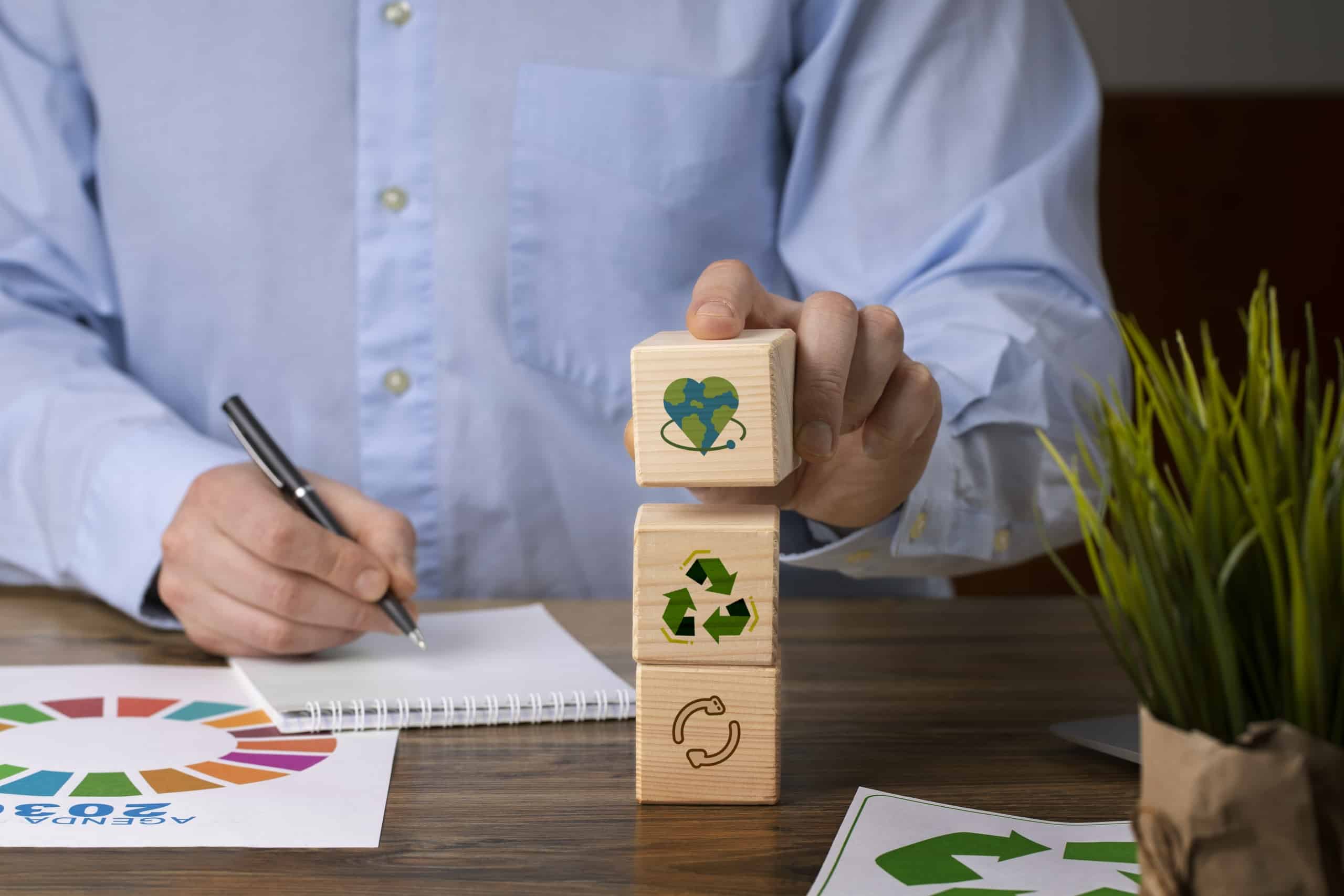1. Biodegradable Films and Wrappers
The use of biodegradable films and wrappers in the packaging of wet wipes signifies a substantial advancement towards achieving environmental sustainability. Conventional plastic packaging, while it successfully maintains the quality of wet wipes, has significant environmental hazards since it cannot naturally break down. Biodegradable films are specifically engineered to undergo natural decomposition over some time, hence minimizing their environmental effect. These films are often produced using sustainable materials such as polylactic acid (PLA), which is obtained from maize starch, or other biodegradable materials including cellulose and starch blends. These materials undergo decomposition into natural components like water, carbon dioxide, and biomass when exposed to suitable circumstances. This process helps reduce the amount of garbage that accumulates in landfills and lessens the strain on waste management systems.
Biodegradable films have a significant benefit in that they may preserve the wet wipes’ integrity and quality, while also providing a sustainable option compared to conventional plastics. These films provide exceptional barrier characteristics against moisture and pollutants, guaranteeing that the wipes retain their wetness and effectiveness until they are used. In addition, the manufacturing process of biodegradable films often requires less energy and releases fewer greenhouse emissions in comparison to traditional plastic manufacture, hence reducing the total carbon footprint. Biodegradable films are an appealing choice for companies seeking to minimize their environmental footprint while maintaining stringent product quality.
Nevertheless, the shift towards biodegradable films and wrappers presents some obstacles. An essential concern is the need for adequate disposal and composting infrastructure to guarantee the planned decomposition of these materials. In the absence of suitable circumstances, such as the presence of industrial composting facilities, the decomposition of biodegradable films may not occur properly. This underscores the need to educate customers on appropriate means of disposal and lobbying for the establishment of composting facilities. In addition, while the price of biodegradable materials has fallen over time, they might still be more costly than conventional plastics, which presents a financial obstacle for some producers. Although there are challenges to overcome, the increasing desire from consumers for environmentally friendly goods is stimulating advancements and financial support for biodegradable packaging. This progress is leading the wet wipes business towards a more sustainable future.
2. Refillable Dispensers
Refillable dispensers are revolutionizing the wet wipes business by providing a sustainable alternative to disposable plastic packaging. These dispensers are designed to be long-lasting and may be used several times, enabling customers to buy wet wipes in large quantities and replenish their containers as required. This not only lowers the quantity of plastic trash produced but also provides a more economically efficient alternative for both customers and producers. By purchasing a durable and reusable dispenser, customers may greatly reduce the amount of disposable plastic packaging they would otherwise throw away, thus helping to decrease overall plastic pollution.
Refillable dispensers have advantages that go beyond just reducing waste. They provide a handy and visually appealing alternative for both families and businesses. These dispensers are often crafted with a focus on both usefulness and beauty, making them an appealing addition to any environment. Refillable dispensers are offered in a range of materials such as stainless steel, glass, and high-grade recycled plastics. This allows them to complement different interior designs while also demonstrating a dedication to sustainability. Certain designs include elements like as child-proof locks and user-friendly dispensing systems, which improve their practicality and ease of use.
Refillable dispensers may result in substantial long-term cost reductions from a financial standpoint. Although the upfront cost of a robust dispenser may be more than buying individually packed wipes, the potential savings in the long run are significant. Purchasing refill packets in bulk is often more cost-effective per wipe compared to buying single-use alternatives. The cost-effectiveness of refillable dispensers makes them an attractive choice for both individual customers and bigger businesses, such as schools, workplaces, and healthcare institutions, that often use wet wipes in huge numbers.
Furthermore, refilling dispensers promote a circular economy by incentivizing the reuse of resources and minimizing the need for ongoing manufacturing of disposable plastics. By using refillable dispensers, brands may bolster their corporate social responsibility (CSR) credentials and attract environmentally concerned customers. This transition not only contributes to the reduction of plastic waste but also establishes enterprises as pioneers in sustainability. To optimize the environmental advantages, wet wipes manufacturers may further provide incentives, such as discounts or loyalty programs, to consumers who choose refill choices instead of single-use products, therefore further encouraging sustainable habits.
Nevertheless, the extensive use of refillable dispensers does provide a distinct set of difficulties. Ensuring the accessibility and ease of obtaining refill packs is vital to the success of this business. Wet wipes manufacturers should allocate resources toward optimizing distribution channels and ensuring the widespread availability of refill packs in both brick-and-mortar and e-commerce establishments. Furthermore, it is crucial to educate customers about the environmental advantages and correct use of refillable dispensers to encourage their acceptance and modify their buying habits. Although facing these obstacles, the increasing consumer inclination towards environmentally friendly goods is expected to stimulate innovation and wider use of refillable dispensers in the wet wipes market.
3. Minimalist Packaging
The wet wipes business is increasingly adopting minimalist packaging in response to the growing demand for eco-friendly goods. This method prioritizes minimizing the quantity of materials used in packaging while ensuring the product’s safety and effectiveness are not compromised. Minimalist packaging reduces plastic consumption and has a smaller environmental effect by simplifying the design and removing extraneous parts. This not only has positive implications for the environment but also resonates with customers who are more aware of their ecological impact.
An important benefit of minimalist packaging is its high level of efficiency. Through the use of thinner and more robust materials, organizations may get equivalent levels of protection and durability while reducing the amount of plastic used. This decrease in the amount of material used immediately results in a reduction in waste and a lesser environmental impact in terms of carbon emissions. In addition, minimalist packaging often leads to lighter goods, hence decreasing shipping costs and emissions. Reducing weight and volume allows for increased product capacity during shipping, resulting in fewer journeys and reduced fuel use, hence amplifying the environmental advantages.
The visual attractiveness of minimalist packaging is an additional feature that contributes to its widespread popularity. Minimalistic, uncluttered designs are often seen as more refined and high-end, hence elevating the entire brand perception. Consumers are attracted to the streamlined and contemporary appearance of minimalist packaging, which helps distinguish a product from others on crowded shop shelves. The emphasis on simplicity and utility aligns with the increasing inclination towards minimalism in lifestyle and customer preferences. Brands that embrace minimalist packaging may use this trend to appeal to a more discerning and environmentally-conscious client base.
Minimalist packaging might result in cost savings from a production standpoint. Wet wipes manufacturers may decrease their manufacturing costs by minimizing the quantity of materials used. This is especially advantageous in a market that is sensitive to prices, where even little cost reductions may have a large effect on profits. Moreover, the efficient design process may expedite manufacturing, hence decreasing the time and resources required to bring a product to the market. These cost reductions may then be transferred to customers, therefore increasing the accessibility and affordability of sustainable goods.
Nevertheless, the process of adopting minimalist packaging is not without its difficulties. It is essential to guarantee that the minimized packaging still offers sufficient protection for the goods. Wet wipes manufacturers must allocate resources toward research & development to achieve an optimal equilibrium between simplicity and functionality. Utilizing advanced materials and new design processes is often necessary to retain product integrity while minimizing material consumption. Furthermore, it is important to take into account and comply with any regulatory obligations about packing.
To optimize the effectiveness of minimalist packaging, wet wipes manufacturers may also prioritize educating customers about its advantages. Effective communication on the environmental benefits of minimizing packaging may improve customer recognition and devotion. Brands may enhance their relationship with environmentally aware customers and establish a favorable image in the market by emphasizing the measures they take to reduce waste and promote sustainability.
In general, minimalist packaging is a clever and environmentally friendly strategy for the wet wipes market. By minimizing material consumption, improving visual attractiveness, and decreasing expenses, it provides a holistic resolution to the environmental and economic obstacles confronting the industry. With customers increasingly valuing sustainability while making purchases, minimalist packaging is expected to have a significant impact on the future of wet wipes packaging.
4. Paper-Based Packaging
Paper-based packaging is becoming a strong and environmentally beneficial substitute for plastic in the wet wipes business. The transition is motivated by the growing recognition of plastic pollution and the need for environmentally-friendly packaging alternatives. Due to its biodegradability and frequent use of renewable resources, paper offers a notable advantage compared to conventional plastic packaging. Recent developments in material science and coating technologies have enabled the use of paper in wet wipes without sacrificing their capacity to retain moisture and provide the necessary durability for protection.
A key advantage of paper-based packaging is its capacity to biodegrade. Contrary to plastic, which may undergo decomposition over many centuries, paper naturally disintegrates over a very short timeframe, therefore greatly diminishing its environmental effect. When obtained from forests that are maintained sustainably, paper packaging plays a role in a circular economy, in which resources are consistently reused and restored. This is consistent with the increasing consumer inclination towards items that do not contribute to the long-term deterioration of the environment.
Paper-based packaging not only has environmental advantages but also has the potential to improve a brand’s reputation. Consumers are progressively seeking environmentally-friendly goods, and firms that embrace sustainable packaging may set themselves apart in a fiercely competitive industry. Paper packaging often showcases an organic, unrefined appearance that attracts ecologically aware customers. Brands may use this visual style by integrating natural tones and simple designs that demonstrate their dedication to environmental responsibility. Not only does this appeal to environmentally concerned shoppers, but it also fosters brand loyalty and trust.
One notable benefit of paper-based packaging is its capacity to be recycled. Paper is a very prevalent substance that is often recycled worldwide, with well-established recycling systems in operation. Companies may promote waste reduction and resource conservation by opting for paper packaging, which is highly recyclable. In addition, the process of recycling paper consumes less energy in comparison to the production of new paper from raw materials, hence reducing the carbon footprint even further. To optimize the potential for recycling, wet wipes manufacturers can include explicit recommendations on their packaging to direct customers on the appropriate methods of disposal.
Nevertheless, using paper-based packaging does present some difficulties. A primary consideration is to ensure that the paper provides good protection against the drying out or contamination of the wet wipes. In response to this issue, producers are now working on creating novel coatings and treatments that improve the barrier characteristics of paper. These coatings are often formulated using water as a foundation and are designed to be ecologically benign. They provide the required protection against moisture while also maintaining their capacity to break down naturally. Ongoing research and development in this field are essential for enhancing the efficiency and feasibility of paper-based packaging.
Wet wipes manufacturers must also take into account the expense associated with paper-based packaging. Although paper is often less expensive than some high-quality plastics, the necessary treatments and coatings to make it appropriate for wet wipes might raise the overall expenses. Nevertheless, with the increasing demand for environmentally friendly packaging and the advancement of manufacturing technology, it is expected that economies of scale would gradually decrease these expenses. Additionally, companies may mitigate the initial higher expenses by emphasizing the ecological advantages and targeting the expanding group of environmentally aware customers who are prepared to pay extra for sustainable goods.
To summarize, paper-based packaging presents a viable and environmentally-friendly substitute for plastic in the wet wipes sector. The biodegradability, recyclability, and favorable customer impression of this material make it an appealing choice for businesses seeking to minimize their environmental footprint. The adoption of paper-based solutions is being driven by continued improvements in coating technologies and rising consumer demand for sustainable packaging, despite limitations related to cost and material performance. Wet wipes manufacturers may contribute to a more sustainable future and fulfill the changing expectations of consumers by adopting paper-based packaging.
5. Plant-Based Plastics
Bioplastics, commonly referred to as plant-based polymers, are a revolutionary advancement in the packaging sector, namely for wet wipes. These materials are produced from renewable biomass sources, such as maize, sugarcane, and algae, providing a sustainable substitute for conventional petroleum-based plastics. Utilizing plant-based polymers effectively tackles several environmental issues, such as the exhaustion of fossil fuels and the mitigation of greenhouse gas emissions throughout the manufacturing process. The wet wipes sector is increasingly embracing plant-based polymers to satisfy the rising customer demand for environmentally friendly goods.
A key benefit of plant-based polymers is their capacity to decrease the carbon footprint associated with packaging. Bioplastic production generally results in lower greenhouse gas emissions compared to traditional plastic manufacture. Polylactic acid (PLA), a prevalent kind of bioplastic, produces considerably reduced carbon emissions due to its sourcing from renewable resources. The plants absorb carbon dioxide throughout their growth period, which serves to counterbalance the emissions generated during the production process. Plant-based plastics are an ecologically friendly solution, which helps in the battle against climate change.
Plant-based plastics not only have environmental advantages but may also improve a brand’s sustainable reputation. As customers gain more awareness of the ecological consequences of their purchases, they are progressively showing a preference for items that come with environmentally friendly packaging. Companies may attract and maintain environmentally concerned clients by transitioning to plant-based polymers. Utilizing packaging that prominently displays labels showing its plant-based origins may function as a potent marketing strategy, demonstrating a brand’s dedication to sustainability and innovation. This may foster trust and cultivate loyalty among customers who prefer environmentally-friendly items.
Another notable advantage of plant-based polymers is their adaptability. These materials may be manipulated to possess comparable characteristics to conventional plastics, such as durability, pliability, and moisture resistance, making them appropriate for packaging wet wipes. Progress in bioplastic technology has led to the development of materials that can efficiently safeguard and maintain the quality of wet wipes. For instance, several types of bioplastics are specifically engineered to be biodegradable in industrial settings, which implies that they may decompose into natural components without leaving behind any detrimental remnants. This guarantees that the packaging does not add to long-term pollution and is in line with the principles of a circular economy.
Nevertheless, the extensive use of plant-based polymers encounters certain obstacles. The cost is one of the primary concerns. At now, the cost of producing bioplastics is often higher than that of regular plastics, mostly because of variables such as the limited supply of raw ingredients and the intricate nature of the manufacturing process. Consequently, organizations may be required to make a larger initial investment to transition to plant-based packaging. However, with the increasing demand for bioplastics and the expansion of manufacturing, it is anticipated that prices will fall, ultimately making these materials more financially feasible in the future.
Another obstacle that has to be addressed is the need for suitable disposal and composting facilities. Although some plant-based polymers are capable of being composted, they need certain circumstances to decompose efficiently, such as those often present in commercial composting facilities. In the absence of adequate disposal infrastructure, bioplastics may fail to undergo decomposition as planned, hence diminishing their environmental advantages. Hence, it is imperative to establish and enhance composting infrastructure and educate consumers on the proper disposal of bioplastic packaging. Moreover, corporations may collaborate with local governments and waste management groups to enhance the composting infrastructure and guarantee the proper processing of plant-based plastics.
Ultimately, plant-based polymers provide a hopeful and environmentally-friendly substitute for the packaging of wet wipes. Their capacity to decrease carbon emissions, improve brand image, and provide flexible packaging options makes them a compelling choice for organizations seeking to minimize their environmental footprint. The use of plant-based plastics is being driven by continued breakthroughs in bioplastic technology and rising consumer demand for sustainable packaging, despite constraints relating to pricing and disposal infrastructure. By adopting these cutting-edge materials, the wet wipes sector may make substantial progress towards a more environmentally friendly future, fulfilling the changing demands of environmentally aware customers and supporting worldwide environmental preservation initiatives.
6. Smart Packaging Solutions
Advanced technology is being integrated into the wet wipes business via smart packaging solutions, leading to a revolution in functionality, sustainability, and customer information. These cutting-edge package designs use technologies like QR codes, NFC (Near Field Communication), and IoT (Internet of Things) to create interactive and intelligent packaging. Intelligent packaging enhances user experience and also contributes to environmental objectives by encouraging appropriate disposal and recycling methods.
An important advantage of smart packaging is its capacity to provide customers with immediate access to product information. Brands may provide in-depth information about a product’s origin, ingredients, and sustainability credentials by including QR codes or NFC tags on the packaging. Consumers may effortlessly scan the code using their smartphones to get this information, enabling them to make better-informed purchase choices. on wet wipes, this information may include specifics on the constituent materials, certifications, and guidelines for appropriate disposal. The openness promotes trust and loyalty among customers, who are increasingly seeking responsibility and traceability from firms.
Intelligent packaging may also have a vital impact on enhancing recycling and disposal methods. Digitally enhanced packaging may provide customers with instructions on proper recycling or disposal methods for the product. For example, a QR code might be used to direct users to a video instruction or a local recycling finder, assisting customers in navigating the sometimes perplexing recycling procedures. This not only guarantees proper disposal of the packaging, hence minimizing environmental effects but also enlightens customers on sustainable practices. Smart packaging may enhance recycling rates and minimize landfill waste by encouraging correct disposal methods.
Smart packaging also offers a significant benefit by improving the efficiency of the supply chain. Internet of Things (IoT) technology integrated into packaging allows for continuous tracking and monitoring of the product from its creation until its disposal. This enables the collection of up-to-date information on the product’s whereabouts, condition, and how it is being handled. This enhanced visibility enables enterprises to streamline their logistical operations, minimize wastage, and guarantee that the product is delivered to customers in the best possible condition. Smart packaging may monitor temperature and humidity levels for wet wipes, ensuring that the storage conditions are suitable to keep their wetness and efficacy. This technology can inform producers and merchants about any potential problems that may affect the quality of the product. This proactive strategy reduces waste and guarantees that customers obtain items of superior quality.
Intelligent packaging solutions may also promote sustainability efforts by minimizing the need for excessive packing. Conventional packaging often incorporates numerous layers and materials to ensure essential information and safeguarding. By using intelligent packaging, a significant portion of this data may be converted into digital format, hence minimizing the need for printed materials and unnecessary layers of packaging. By streamlining, resources are conserved and transportation emissions are reduced via the reduction of package weight and volume. Moreover, intelligent packaging may be specifically engineered to be reusable, therefore motivating customers to reuse the packaging and effectively minimize waste.
The use of intelligent technology in packaging also presents fresh prospects for marketing and customer involvement. Brands can use smart packaging to provide interactive and customized experiences for customers. Scanning a QR code on a wet wipes container, for instance, might provide access to special information, promotional offers, or loyalty benefits. This interactive feature has the potential to improve the whole customer experience, increasing engagement and promoting brand loyalty. Furthermore, intelligent packaging can gather significant data on customer behavior and preferences, allowing firms to customize their marketing campaigns and enhance product offers.
Although smart packaging systems provide many advantages, their implementation can present obstacles. Wet wipes manufacturers must carefully evaluate the advantages of technology and infrastructure investments to ensure that the additional costs are justified. Furthermore, the level of consumer knowledge and willingness to embrace smart packaging is continuing to increase. It is essential to educate customers about the benefits and use of smart packaging to ensure its success. Companies must also confront privacy problems associated with data collecting and guarantee that the information obtained is used appropriately and with transparency.
Smart packaging solutions provide a revolutionary method for the wet wipes business, integrating cutting-edge technology with sustainability and customer involvement. Smart packaging has the potential to greatly benefit customers and producers by allowing immediate access to product information, boosting recycling habits, increasing supply chain efficiency, minimizing excessive packaging, and delivering interactive experiences. Smart packaging is expected to have a significant impact on the wet wipes business, stimulating innovation and promoting sustainability, as technology advances and consumer demand for eco-friendly goods increases.
7. Eco-Friendly Printing Techniques
Companies in the wet wipes business are placing more emphasis on eco-friendly printing processes to minimize their environmental footprint. Conventional printing techniques often use noxious chemicals and consume substantial amounts of energy, so contributing to pollution and carbon emissions. On the other hand, eco-friendly printing methods use sustainable procedures and materials to reduce these adverse impacts. By using these strategies, firms may greatly improve the sustainability of their packaging while satisfying the increasing customer demand for more environmentally friendly goods.
Water-based inks are a very efficient method for environmentally friendly printing. Water-based inks, in contrast to solvent-based inks, do not include volatile organic compounds (VOCs) that may cause damage to the environment and human health. Instead, water-based inks are mostly composed of water and natural colors. These inks have lower toxicity levels and emit fewer substances throughout the printing process, making them a safer option for both workers and the environment. In addition, water-based inks possess the quality of being biodegradable and are more easily cleansed, hence decreasing the need for strong chemicals during the cleaning procedure and further lowering the environmental consequences.
Another novel strategy involves the use of vegetable-based inks, which are obtained from sustainable sources including soy, linseed, and maize. Not only are these inks ecologically safe, but they also provide vivid colors and prints of superior quality. Vegetable-derived inks possess a reduced carbon footprint in comparison to inks derived from petroleum and are often more readily decomposable. This makes them a very suitable option for enterprises seeking to diminish their dependence on fossil fuels and advance sustainability. The use of vegetable-based inks is also in line with the wider movement towards using renewable resources in the production of goods.
Digital printing is a sustainable printing method that provides a wide range of environmental advantages. Digital printing eliminates the need for printing plates by immediately transferring pictures from a digital file to the substrate. This procedure obviates the need for plates, hence reducing waste and the use of primary resources. Digital printing enables more accurate ink application, hence reducing ink loss. Moreover, it facilitates the manufacture of smaller print quantities and allows for printing on demand, hence decreasing excessive production and the resulting waste. The versatility of this feature is especially beneficial for the wet wipes sector since packaging requirements might differ significantly.
Companies may minimize their environmental footprint by optimizing their printing operations, in addition to using sustainable inks and printing procedures. Implementing ink reduction tactics, which aim to limit ink use while maintaining print quality, may result in substantial savings in both ink and energy consumption. Introducing recycling initiatives for printing materials, such as ink cartridges and printing plates, also aids in resource conservation and waste reduction. In addition, the use of energy-efficient printing equipment and techniques may reduce the total carbon footprint of the printing activity.
Environmentally conscious printing methods can apply to the choice of printing materials. Opting for recycled or sustainably produced paper and cardboard for packaging may enhance the use of environmentally friendly inks and techniques. Obtaining certifications like FSC (Forest Stewardship Council) or PEFC (Programme for the Endorsement of Forest Certification) guarantees that the materials used originate from forests that are maintained responsibly. Companies may adopt a comprehensive strategy for environmentally friendly packaging by including sustainable materials in their printing processes.
It is essential to educate customers about the advantages of environmentally friendly printing to promote the use and recognition of sustainable packaging. Transparent labeling and effective communication on the use of eco-friendly inks, procedures, and resources may bolster a brand’s reputation and establish credibility with environmentally aware customers. Wet wipes manufacturers may use environmentally friendly printing as a marketing strategy, showcasing their dedication to sustainability and setting themselves apart in a competitive market. This level of openness not only fulfills the consumer’s need for environmentally friendly items but also promotes the adoption of more sustainable shopping habits.
Ultimately, environmentally-friendly printing methods are a vital element of sustainable packaging in the wet wipes sector. Wet wipes manufacturers may greatly diminish their environmental footprint by using water-based and vegetable-based inks, utilizing digital printing techniques, and optimizing their printing procedures. By using these methods, together with the use of sustainable materials and effective customer messaging, firms may effectively cater to the increasing need for environmentally friendly goods. Amidst ongoing industry advancements, the use of environmentally conscious printing techniques will be crucial in fostering a more sustainable future for the packaging of wet wipes.
8. Compact Packaging
The wet wipes business is increasingly using compact packaging as a successful approach to minimize environmental consequences and enhance logistical efficiency. Wet wipes manufacturers may optimize the sustainability of their goods by creating packaging that requires less material and occupies less space, resulting in less waste, cheaper transportation costs, and improved overall sustainability. This strategy is in line with the growing customer need for environmentally friendly products and assists firms in complying with strict environmental requirements.
A key advantage of small packaging is the substantial decrease in material use. Conventional packaging often employs an excessive amount of plastics and other components to guarantee the safeguarding of products. Compact packaging, in contrast, prioritizes the optimization of design to minimize the use of materials while ensuring the product’s integrity and safety. The decrease in material not only preserves resources but also reduces waste production, resulting in a lower environmental impact.
The logistical benefits of small packaging are also remarkable. Reduced package size and weight allow for increased unit capacity in each shipment, resulting in fewer journeys and hence less fuel consumption and carbon emissions. This efficiency also applies to storage, as tiny products occupy less space in warehouses and store shelves. Compact packaging offers customers the advantage of convenience for storage and travel, as it may easily fit into bags and drawers without occupying a significant amount of room. This pragmatic element improves the whole customer experience and contentment.
Compact packaging offers not only environmental and logistical advantages but also economic reductions for both producers and customers. Reducing material consumption and enhancing transportation efficiency might result in decreased production and shipping expenses. By transferring these cost reductions to customers, eco-friendly items may become more economical and readily available. Cost-effective and sustainable packaging solutions may assist firms in distinguishing themselves and appealing to price-sensitive, environmentally conscientious customers in a competitive market.
Compact package designs often use inventive methods to enhance product display and functionality. Wet wipes, for example, may be packed in compressed and stacked configurations that expand when opened, maximizing the amount of product while using little packaging. These designs not only save space but also provide a distinctive and attractive user experience. In addition, the inclusion of resealable elements in compact packaging may effectively preserve the freshness of the product and prolong its shelf life, thus enhancing its value for the customer.
Nevertheless, the process of shifting to compact packaging requires meticulous evaluation of several issues. An essential obstacle is in guaranteeing that the diminished package still offers sufficient safeguarding and preserves the quality of the wet wipes. Wet wipes manufacturers must allocate resources towards research and development to provide durable and dependable small packaging solutions. To achieve the perfect combination of simplicity and practicality, it is frequently essential to use sophisticated materials and creative design methods. It is essential to preserve customer confidence and happiness by ensuring the safety and effectiveness of the product, while also lowering the size of the package.
In addition, small packaging should also take into account the convenience and availability of all customers. The designs should prioritize intuitiveness and user-friendliness, while also ensuring that the small size does not affect the convenience and efficacy of the product. For example, it is crucial to have user-friendly characteristics such as easily accessible functions and visible labeling to guarantee that customers can readily use the product. By taking into account these usability aspects, organizations can guarantee that their small packaging solutions are both functional and attractive.
To optimize the effectiveness of small packaging, organizations need also to prioritize customer education and communication. Emphasizing the ecological advantages and financial savings of small packaging may increase consumer awareness and encourage widespread use. Open and honest communication on the sustainability activities and innovations used in the package design may foster brand loyalty and trust among environmentally aware customers. Wet wipes manufacturers may use their dedication to small and eco-friendly packaging as a crucial factor that sets them apart in their marketing strategy.
To summarize, compact packaging provides an intelligent and environmentally-friendly option for the wet wipes business. Compact packaging effectively tackles the environmental and economic difficulties in the industry by minimizing material consumption, enhancing logistical efficiency, and cutting prices. Novel designs and sophisticated materials are essential in ensuring that compact packaging effectively fulfills the requirements of both producers and consumers. With the increasing demand for environmentally friendly goods, compact packaging is expected to play a crucial role in the future of sustainable wet wipes packaging.









